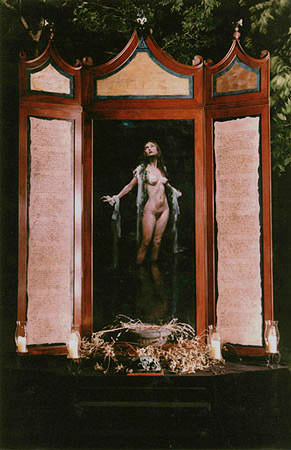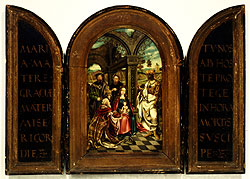A Note on
Triptych Altarpieces

In
2002 I had a short and hot flamewar with Rob Howard of the Cennini forum.
During a mutual critique in which he singled out my Triptych Altarpiece of
Harriet Westbrook Shelley for attack, he said this: "Somehow, the
thought of people worshipping at that Mons Veneris strikes me as positively
satanic.... Also, when painting a triptych, it's always wise to paint THREE
pictures. What you have is a folding screen with a nude in the middle....Every
other triptych I've seen had THREE painted panels. That's why they call it a
TRI-ptych, you know, like TRI-plets, TRI-cycle and TRI-again with another lame
excuse."
My response to the first quip was this: "If
the mons veneris frightens you, perhaps you should limit yourself to painting
men."
The second part of his attack requires a somewhat
fuller response, since it is not a question of Howard's unnatural (though
pandemic) cathexis but a question of fact. I had assumed at the time that my
triptych was a sort of historical first, in that with the three panels of art I
had mixed art forms in an unprecedented way. No one will deny that poetry is an
art form, and original poetry in calligraphy may certainly be called a visual
art. We have three panels; three panels of visual art is a triptych.
It turns out that I was wrong in a sense, and that
Howard was wrong in a rather larger, absolute, sense. I was wrong in that
although my triptych may have been relatively rare, it was not completely
unprecedented. With a bit of research (or, actually, luck in travel) I
discovered that in medieval times triptychs with Biblical quotes on the two
side panels were not uncommon. As an example, I offer an anonymous triptych now
hanging in the Memling Museum in Bruges, Belgium, dated 1545 and called A
Triptych of the Adoration of the Magi. A quote from the gospels written in
calligraphy on the side panels flanks a single oil painting depicting the
adoration. The literature tells us that this was just one of many such
triptychs.

I still claim that my triptych may be unique in
that the oil painting, the calligraphy, the text of the poetry, the sculpture,
and the design of the frame and base were all by the same artist. If it is not
unique, it is certainly rare. I would appreciate it if any historians who know
of precedents would contact me, so that I may be correct in my claims. It is
not of fundamental importance to the artistic effect, but it is nice to know
the truth of the matter nonetheless.
I will close by addressing a final implication of
Howard. If I have proven that my work is a triptych I have not yet proven that
it is altarpiece, since the idea of an altar to Harriet Shelley may at first
seem odd. She is not, after all, a god or saint. But the religious gods and
saints are primarily symbols; they stand for virginity or chastity or some
other abstract principle. A goddess or female saint stands for a part of
womanhood. In the same way, I suggest in the triptych that Harriet Shelley
powerfully symbolizes millions of women in history. Once you have read the poem
and understood the significance of the work as a whole, you see that her
similarity to religious martyrs is striking. Many female religious martyrs have
been sexual martyrs. Mary Magdalene is the first example that comes to mind.
What I have done here is create a new iconography
(in several meanings of the word) from a recent historical event. That is to
say, this historical event (the two drownings) is recent enough to resonate
with current emotions and crises and yet old enough to allow it to be
mythologized.
I have to admit that my artistic inspiration was
not so cerebral or premeditated. I chose the story primarily because it spoke
to me personally—to recent events in my own life. I was not seeking it; it was
a fateful collision. I assumed, perhaps naively, that my attraction to the
story might be a universal attraction, once its larger aspects were made clear.
I have so far resisted adding this sort of
expository writing to the triptych, hoping that the work was not completely
opaque. I had hoped that the work might even be embraced by feminists, who
would see it as a woman-inspired work written and created from the point of
view of the woman. But for the most part women (and especially American women)
have been put off by the nudity and the fact that the artist is a man. They
cannot judge the work on its merits. It is believed, perhaps, that man cannot
have any deep insight into woman, or anything important to say on the subject
intellectually or emotionally.
Or perhaps I am extrapolating too far from the
relatively few comments I have collected. The work has not been seen in the
flesh by a great number of people and it is admittedly quite difficult to
digest online.
Addendum: I have been asked by a reader if I might not have let a piece of the
tattered dress cover Harriet's pubic area, as a nod to decency. My answer: no,
nor to prudery or marketing either. I admit that I had considered it. I am not
unaware of the world around me. But the artistic effect I desired was ruined by
any censorious drapery. I wanted Harriet to look ghostly and despoiled, and my
most squeamish readers are only lucky I did not make her even less appealing.
In my opinion she looks considerably better than a strict documentarian would
allow. I did not want a bloated corpse to arise from those rushes, since my
effect was to be tragic, not disgusting. But I did spend some effort, I
remember, making the hair on her head look wet and dirty. The first time I
painted it she looked a bit too much like Brooke Shields rising from the Blue
Lagoon, and I had to stick her hair closely to her head to keep it from looking
like a Hollywood re-enactment. In the poem it is clear that Harriet's cry is
against all male idealisms, which would include prim saints and shaved or
trimed goddesses. Beyond that, a ghost could hardly arise from the Serpentine
in 1825 with a Brazilian bikini wax. Once I had chosen to fly in the face of
all small thinking, this was the only choice.
At the time, I had reasoned that if the modern
world could accept Nerdrum's traffic victims and Saville's and Freud's rotting
skintones they could accept my wild and untrimmed ghost of Harriet. The
problem, of course, is that I didn't go far enough to attract the avant garde.
I got caught in between theories. I had stepped well beyond the frigid good taste
of contemporary realism but had not achieved the gratuitous shock value of a
sheep sawn in half. Classical tragedy, like epic or elegiac poetry, is now a
field with no practitioners and no market, as is all earnestness or grandeur in
conception. I had updated and expanded a genre that could no longer be
assimilated by the modern viewer, and neither my technique nor my novelty could
overcome this fact. The realists, who might otherwise admire my technique,
found my conception bizarre. The avant garde, who might otherwise admire my
novelty, could not accept that I took history seriously, or took anything
seriously. Nor could they possibly accept rhyming poetry, classical allusion,
or an undeconstructed sexual desire.
In the end, I consider this the work's ultimate
strength. It is unfashionable in every conceivable way. It purposely and
simultaneously breaks all the rules of both realism and the avant garde. In
doing so it re-establishes a pre-modern conception of expression and
creativity, one that is much more useful to the real artist. This conception is
not based upon technique or theory, but upon emotion and inspiration. It is the
supplication to one Muse or another, the praying at the altar of some goddess
or saint of ones own making.